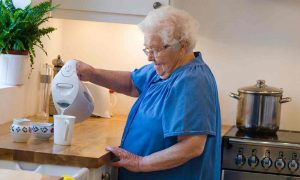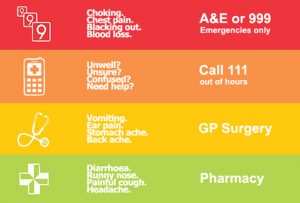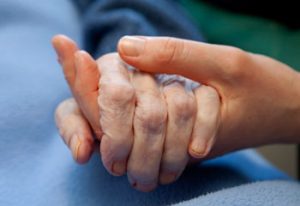Latest News
Mental health target being ignored
Freedom of Information figures suggest a quarter of clinical commissioning groups are ignoring the target.
NHS England says it is investing more money in services, to help meet demand.
Early intervention
The waiting-time target requires that any patient aged 14 to 65 experiencing their first episode of psychosis – a mental health problem that can involve delusions or hallucinations – receives treatment within two weeks of referral.
But the FOI request, sent to the 209 CCGs in England by the Liberal Democrats, shows that in some areas this is not happening.
Of those that responded (170 out of the 209), 23% said they had applied the target to for 14- to 35-year-olds only. And more than three-quarters of those had no firm plans to extend it to 35- to 65-year-olds this year.
The package of intensive treatment that should ne provided, known as early intervention in psychosis (EIP), involves support for patients from a range of health professionals, including psychiatrists, mental health nurses and social workers, and should match the “best practice” blueprint contained in guidelines laid down by the clinical watchdog NICE.
Evidence-based treatment
But documents seen by the BBC suggest most mental health trusts in one part of England were unable to say whether their care package had been delivered in line with the NICE requirements.
NHS England estimates EIP should cost the NHS £8,250 a year per patient.
About 64% of the CCGs that responded to the FOI request did not or could not say what they were spending on EIP, and another 29% said they were spending below £8,250 per patient. Meanwhile, 32% of the CCGs could not say what their overall planned spending on EIP would be this year.
Liberal Democrats health spokesman Norman Lamb said: “It shows that across the country people are not getting the evidence-based treatment set out in the programme.
Psychotic symptoms
“It is like saying to a cancer patient, ‘You can have the chemotherapy, but you cannot have the radiotherapy.'”
Sarah Broadbent runs campaign group 25Percent, so named because, over the course of any one year, a quarter of the population is said to suffer from a mental health problem.
Her brother, Matthew, had his first breakdown and psychotic symptoms at the age of 18.
During the two decades since then, he has received care, in and out of hospital, she describes as “patchy at best, negligent at worst”.
Limited joy
At the start of her brother’s illness, EIP had not been launched in the NHS.
Had it been available, she said, her brother’s life would have been very different.
“I’m not suggesting he would have been one of life’s high-flyers, but I think he could have gone on to have had a life which has more stability and I think probably joy,” she said.
“Matthew’s life is very lacking in joy, and a life of 23 years gone by with limited joy and just torment is a pretty punishing way to exist.
Extra funding
“All the evidence supports the fact that early intervention can improve your educational attainment, improve job opportunities and physical health.”
An NHS England representative said: “There will be extra funding for 10% more people to be treated in two weeks from 2017-18, building to £70m a year by 2020-21.
“The evidence stacks up that these services help people recover and gain a good quality of life.”
Scotland and Wales have early intervention programmes for serious mental illness, but no standard for waiting times for treatment.
Northern Ireland does not have a similar service.

A future of mobile-centric healthcare could save lives
Picture the scene: an elderly woman with bronchitis is overcome by breathlessness while out for an afternoon shop. Instead of ignoring the problem, she immediately turns to her mobile phone, which is measuring her breathing rate and integrating that reading with other personal health data. The program decides that she needs a GP consultation within two hours, books it at a local walk-in centre and even tells her which bus to catch.
Far from being science fiction, this kind of scenario represents the kind of reality the NHS must work towards, says Sir Bruce Keogh, NHS England’s medical director. With spiralling costs, demand increases and staffing issues squeezing existing resources, a future of mobile-centric healthcare would increase efficiency – and maybe save lives.
Deborah El-Sayed, director of digital and multi channel at NHS England, says that the focus comes from a realisation that mobile phones are now central to our lives: “The NHS has often been 10 years behind other businesses in terms of technology, but this time we are trying to bring healthcare to people to fit in with the way they live their lives.â€
Salford Royal hospital’s chief information officer Rachel Dunscombe is excited at the possibilities that the mobile phone offers, but she is worried about data security and the breakneck rush at which technological innovations are being introduced. She says: “A few well-thought-out and correctly aimed interventions will do far more than a scattergun introduction of funky toys.â€
At the recent public health conference in Manchester, Keogh highlighted three areas where healthcare is already progressing with the aid of technology.
Monitoring individual health
One big innovation is the move towards monitoring lifestyle data instead of clinical data so that the effect of diet and exercise can be assessed as well as the efficacy of drugs. This is where wearables come in.
A good example is Diabetes Digital Coach – a project led by the west of England academic health science network in partnership with Diabetes UK and technology companies including Hewlett Packard Enterprise. It uses software that communicates with wearable sensors to enable people with type 1 or type 2 diabetes to self-manage their condition.
A number of hospital trusts throughout England are trying out a product called AliveCor, which uses two pads in a phone case to take medical-grade electrocardiograms, sending it to a cardiologist and instantly embedding the information into a patient’s records. Arrhythmias can cause sudden cardiac death, which kills 100,000 in the UK annually – according to the Arrhythmia Alliance, 80% are avoidable.
Using clinical and lifestyle data to achieve personalised healthcare depends on the successful use of massive databases. The Department of Health is using expertise from the aerospace industry to set these up.
Creating a trusted channel for information
Those who have searched for health information online will know how many sources there are and how difficult it is to find one you can trust. Diabetes is a case in point. According to El-Sayed, patients do better if they self-manage their condition. However, many still don’t – 100 diabetics every week undergo avoidable limb amputations.
Work is underway to upgrade NHS Choices, ensuring the 1.7 million individuals who use it every day are given the best possible information wherever they are. Meanwhile, newly-diagnosed diabetics are trialling a version of the NHS.uk site that sends information to their phones.
Mobiles are also being used in an NHS telemedicine project at Airedale nursing home in which 10,000 care home residents receive video consultations from their rooms, with the team able to access the full patient records. This has resulted in a large reduction in hospital-bed deaths and £117,872 in savings due to reduced visits to hospital A&E.
Devices that communicate with each other – Internet of Things – can be used to keep track of elderly and unwell people in care homes. A simple socket that plugs into household devices can now be used to monitor elderly and unwell people. If plugged into a kettle, it could send a message directly to a carer’s mobile phone if an older person has failed to make their morning cup of tea by a certain time.
Creating personalised care using electronic patient records
Historically, the greatest obstacle to technological progress in the NHS has been getting multiple systems to work together. Fhir (pronounced “fireâ€), which stands for Fast Healthcare Interoperability Resources, allows computers to exchange electronic health records by using an application programming interface.
Salford clinical commissioning group is leading the country in Fhir’s implementation and has a testbed working in partnership with NHS organisations in Greater Manchester, Cumbria and Lancashire.
Fhir – which is being developed in the US for introduction in the UK in 2017 – enables computers to send parcels of patient information such as body temperature or blood pressure in a format that other computers can understand and use. This makes accessing personalised medicine through mobile phones more than just a dream.

Disadvantaged teenagers left isolated as clubs and holiday camps are closed
Youth clubs and adventure camps that once attracted hundreds of thousands of young people during term time and summer holidays have shut their doors over the last few years, following a battery of cuts to youth services that have left disadvantaged teenagers idle and isolated. From Kent to Manchester, clubs where young people escaped from daily stress now sit derelict. Others have been sold off and developed into cafes or private care homes. And the cuts come amid the slashing of adolescent mental health services and careers’ advice throughout England.
In Trafford, in Greater Manchester, the council shut all seven of its youth centres last year, shrinking its youth service budget by more than half. Dotting the borough’s deprived neighbourhoods, the council-run clubs were a haven for teenagers, with staff supporting them through challenges ranging from sexual health issues to finding employment.
For Katie Abbott, 17, who used to spend afternoons at her local club, the closures felt like a move against the already marginalised. “People who have the money for private mental health care, or careers advice, will get that support anyway, but this is hitting harder on people with less money,†says Abbott, who now has no access to summer programmes and stays at home with little to do. “If you don’t have a stable home life, and a lot of people in Trafford don’t, now there’s no place to find a release.â€
Youth workers, advocates, and local people, say that as a result of the closures crowds of youngsters are hanging around street corners, drinking and bullying others. “Relentless cuts to youth budgets have made it much harder for staff to connect with local youngsters,†says Lizanne Devonport, a regional organiser for trade union Unison in the north-west, which represents youth workers in Trafford. “And you now see large groups of teenagers congregating around stations, shops and parks.â€
The problems are not confined to Trafford. A survey of youth workers across the UK by Unison, published later this week, has found that 83% of respondents said cuts to services had led to increased local crime and anti-social behaviour.
Trafford council is in the process of establishing a youth trust, a charitable organisation that will look to raise funds from outside local government to commission additional youth services. “Local government is fundamentally changing,†says Jill Colbert, Trafford’s corporate director for children, families and wellbeing, “and civic society has a greater responsibility to meet the needs of its communities.†For now, social enterprises have stepped in to run a couple of the former centres one night each week.
In response to steep budget cuts by central government, a handful of other English councils are also trying to establish alternative models that raise private funds for youth work. In 2010-11 local government spending on youth services in England was £1.2bn. By 2013-14 it had fallen to £712m (a 40% drop) according to the most recently analysed data. But the new groups for young people are all faced with the same daunting question. Who, exactly, is going to pay?
In 2010, the coalition government trumpeted public service mutuals as a way to maintain public services in the face of cutbacks to non-statutory provision. Youth workers and other hard-hit local government workers could set up employee-led cooperatives, the government argued. The theory was that the mutuals would preserve the public service ethos while attracting private money to supplement dwindling state funds. These new groups could enter into a short contract with the council and later bid to run the service in the open market.
But six years on, only three councils have managed to mutualise their youth services. Most others have scrapped universal clubs in favour of programmes targeted at vulnerable groups and have whittled provision down to a spindly core, saving an estimated £500m. Experts fear that the youth service’s early intervention work is fast being eroded. “Now, young people aren’t being supported, just because they aren’t flagged as at risk of criminal behaviour or sexual exploitation,†says Janet Batsleer, principal lecturer in youth and community work at Manchester Metropolitan University.
Knowsley Youth Mutual is one attempt at mutualisation in which former council employees now run a youth enterprise in the second most deprived borough in England. Although the north-west council has shrunk its core youth service budget by nearly half since 2010, KYM continues to run 14 youth clubs, and maintains the preventative side of the service.
Early this summer holiday, some 50 young people milled about the halls of a KYM club, playing football in the gym, giggling over a quiz on the dangers of Pokémon Go, and dreaming up day trips with staff. “Can we go sailing?†a lanky 16-year-old asked, bouncing on her seat. “Could do, actually, and gorge walking, and archery,†a youth worker responded to the group of young girls seated around him.
Bethany Duffy, 18, is a regular at her local club in Knowsley. Four years ago, her mother’s death sent her into a tailspin of street-drinking and petty crime, and she was excluded from school. Estranged from her father, Duffy was sofa surfing and found refuge in the youth club, where staff soon became close confidantes.
“I was anxious, I was angry, but as soon as I started getting my feelings out something changed,†says Duffy, seated by the pool tables in the centre.
Asked how life would look if the centres weren’t around, she says: “I think that I’d be in jailâ€. A youth worker encouraged her to get involved with in-house counselling and meeting groups for unemployed teenagers, and she is now applying for college. “I’ve got my head screwed on,†Duffy says. “And, in a way, they gave me my childhood back, too.â€
Sandra Richardson transferred her team of youth workers from Knowsley council to a youth mutual in 2014. She had tracked neighbouring councils’ cuts and saw that the end was nigh unless she and her team took matters into their own hands. But council funding for KYM’s open-access clubs has fallen each year since austerity kicked in – from £1.6m for universal youth services in 2010 to £860,000 for KYM’s clubs today – and the organisation is struggling to secure new revenue streams. Meanwhile, its council contract ends in 2018.
“It’s a flawed assumption that if youth services were to spin out they would flourish in the open market,†says Richardson. “It’s a really difficult market, and at the end of the day, we’re not businesswomen, we’re youth workers trying to run a business.â€
In the last six years, the number of teenagers in Knowsley’s youth services has dropped from 7,000 to fewer than 4,000, in part because funding for KYM’s clubs has fallen. But a spokeswoman for Knowsley council says: “While other councils have had to cut or significantly reduce their youth offering as budget cuts have continued year on year, the creation of KYM has allowed many of these services to continue in Knowsley.â€
London’s Lambeth, and Kensington and Chelsea, councils are the only others to mutualise their youth services, with varying early success. Young Lambeth Co-op has raised only £112,000 from outside the council in its first year, but hopes to triple that figure next year through grants, donations, and consultancy. Epic CIC, in west London, has managed to bring in an external income, signing contracts with health groups and landing EU grants, too (although the recent Brexit vote means European funding could be off the table).
The difficulties in spinning out into public service mutuals extend well beyond youth agencies. But to date youth services have seen the least growth in public service mutuals of any sector. Youth workers face an extra hurdle with hard-nosed investors, who often ask to see measurable social outcomes. “We’ve been challenged to show outcomes in the same way as Pfizer would demonstrate the impact of a drug. But it doesn’t work that way – we aren’t producing uniform pills,†says Jon Boagey, associate director of the National Youth Agency, which supports youth work.
Rigorous research on whether youth clubs effectively reduce unemployment, crime and drug use is sparse and out-of-date. Only two major national studies have been carried out, over a decade ago, both by the then Department for Education and Skills, and the conclusions were mixed.
But some experts say such measures don’t capture the value of youth work. “We should really be linking youth services to personal health, family health and wellbeing,†says Batsleer. “With these cuts, there is a big risk of abandonment and neglect, and an entrenchment of deprivation.â€
Indeed, in Rotherham, where gangs were found to have sexually exploited 1,400 children between 1997 and 2013, youth workers close to the victims were some of the first to hear of the horrors. The staff then played a pivotal role in uncovering the sweeping scope of abuse that put the perpetrators behind bars. But funding for universal youth work has been slashed in Rotherham in recent years with half of its 22 youth clubs closed and targeted programmes for “at-risk†youth again the main focus. Struggling teenagers who don’t register as vulnerable no longer have youth workers to confide in.
Back in Knowsley, the youth clubs continue to cling on. Cooking classes have gone, as have music courses and dance instructors, and some clubs have reduced their opening hours.
Those who keep coming can sense the threat of closure, and don’t like what awaits them on the other side. “My younger brother hasn’t been coming to the club anymore,†says 17-year-old Georgia Graves, lowering her voice and leaning forward in her chair. “I worry that means he’s going downhill.â€

Sample section from Alzheimer’s Society guide to catering for people with dementia
Finger food
At mealtimes people with dementia may struggle to eat using any type of cutlery as their dementia progresses. Difficulties with co-ordination may develop and consequently the person may find picking up food and eating with their fingers much easier to do. Foods that are eaten with the hands are called finger foods. In essence finger foods are like party or buffet foods – easy to pick up and eat. For many people with dementia this is far preferable to having someone else ‘feed’ them. It is a more dignified way of eating and offers the person greater control over their mealtime as they can choose what they eat from a plate. This control is also a boost to self-esteem and confidence at mealtimes which can help to improve well-being and food intake. Finger foods can also be eaten whilst standing or on the move, which is ideal for those people who have difficulty remaining seated for a meal
Finger foods – the benefits
- They enable people to feed themselves, thus maintaining independence at mealtimes.
- They help to preserve eating skills.
- They can renew interest in food and stimulate appetite.
- They can improve food intake and leave less waste.
- They can boost confidence and self esteem at mealtimes.
- They allow greater choice at mealtimes and freedom to eat as desired.
- They are served at room temperature so do not need to be kept warm.
- They are ideal for people who need time to eat as they do not go cold.
- They are easy to eat.
Providing a finger food menu can be hugely beneficial for people with dementia. However, such a menu needs to be creative and varied, as people can quickly tire of a repetition of small sandwiches and sausage rolls. Consideration of food texture is also important, if a person prefers soft foods, then raw vegetables are not going to be popular, however cheese spread on finger slices of bread may be perfect.Finger foods are easy to prepare in advance as they are served at room temperature; there is no rush to get people to eat, as they do not go cold if a person eats slowly. People with dementia may have fluctuating capabilities from one mealtime to the next and may respond better to finger foods at certain mealtimes than using a knife and fork.It is worth bearing in mind that some people may take a while to adjust to eating with their hands and may initially reject the meal or seem uncertain what to do. Care staff need to take the time to describe the food on the plate, show the person what to do so that they can copy the actions and allow the person time to look at the food and explore it.
Finger food options
When devising finger food menus, consult menu planning guidelines to ensure meals are balanced and varied. All food groups need to be represented in appropriate quantities to ensure good variety and nutritional balance. Here, options for finger foods have been listed under the relevant food groups.
Bread, cereals and potatoes
Try a variety of breads for interest including wholemeal and white. Keep sandwiches small so they are easier to manage.
- buttered toast or bread fingers
- small bread rolls with butter
- small sandwiches
- buttered crumpets or muffins
- bite size crackers with butter or soft cheese
- scones, malt loaf, fruit loaf, teacakes of hot cross buns
- waffles
- slices or mini naan bread pieces
- slices or finger pitta bread pieces
- potato wedges and chunky chips (try sweet potatoes)
- small roast potatoes
- small boiled potatoes or cut into half
Meat, fish, eggs and cheese
Meat that is dry may be difficult to eat so keep it moist. Slice meat and cut into pieces or cubes. Examples include:
- tender meat eg beef, pork or lamb
- chicken or turkey breast (moist)
- small meatballs, sausages and chipolatas
- pieces of meatloaf
- gammon pieces with pineapple cubes
- pieces of fish fillet, (boned)
- small fishcakes and fishfingers
- vegetable burgers or sausages cut into pieces
- hard boiled egg quartered
- chicken nuggets or scampi pieces
- mini quiche
- meat /fish pieces kebab style
- cheese cubed or sliced
Vegetables
- Vegetables can be steamed, boiled or served raw, depending upon what the person prefers and can manage
- carrot, swede or parsnip cut into sticks or cubes
- broccoli spears
- cauliflower florets
- brussel sprouts
- whole green beans or mangetout
- celery sticks (fill with cream cheese) or pieces
- cherry tomatoes
- salad tomatoes cut into wedges
- sliced peppers
- baby mushrooms
Fruit
Fruit can be peeled if preferred.
- banana mini whole, chunks or slices
- melon chunks
- pineapple chunks
- orange segments
- slices of kiwi fruit
- apple or pear chunks or slices
- strawberries, raspberries and blueberries
- apricots (stone removed) and halved
- nectarines or peaches (stone removed) cut into halves
- seedless grapes
- ready-to-eat dried apricots, pears, apple rings, stoned prunes or figs
Miscellaneous sweet and savoury
- slices of cake
- mini sweet muffins or doughnut rings
- mini cookies
- biscuits
- pieces of flapjack
- sponge pudding cut into chunks, offer custard to dip into
- cereal and fruit and nut bars
- finger slices of toast and bread with peanut butter, jam, lemon curd, honey or chocolate spread
- slices of pork pie
- mini sausage rolls
- pizza, mini pieces or sliced
- finger slices of grilled cheese on toast
- finger slices of toast or bread with cheese, pate, tuna mayonnaise or fish paste
- bhajis and mini samosas
This is an excerpt from the publication, Alzheimer’s Society guide to catering for people with dementia. If you would like to purchase a copy, please visit their online shop.

Care Farming Explained
Care farms:
- Provide health, social or educational care services for individuals from one or a range of vulnerable groups. Includes people with mental health problems, people suffering from mild to moderate depression, adults and children with learning disabilities, children with autism, those with a drug or alcohol addiction history, disaffected young people, adults and people on probation.
- Provide a supervised, structured programme of farming-related activities, including animal husbandry (livestock, small animals, poultry), crop and vegetable production, woodland management etc.
- Provide services on a regular basis for participants, where clients/participants attend the farm regularly as part of a structured care, rehabilitation, therapeutic or educational programme.
- Are commissioned to provide care farming services by referral agenciessuch as social services, health care trusts, community mental health teams, education authorities, probation services, Connexions etc. Clients can also be self-referred as part of the direct payments scheme, or be referred by family members.
- Utilise the whole or part of a farm. Be they commercial agricultural units, smallholdings or community farms.
The nearest Care Farm is Vauxhall City Farm 165 Tyers St, London SE11 5HS for more information check out their website here

Local Care Record shortlisted for award
The EHI Awards are the UK’s only dedicated healthcare IT award scheme, showcasing excellence in using IT and digital technology to improve patient care and experience.
The Local Care Record joins-up patient records between GP practices in Lambeth and Southwark and Guy’s and St Thomas’, King’s College Hospital and South London and Maudsley NHS Foundation Trusts. It enables healthcare professionals to view a patient’s medications, previous treatments, test results and any other clinical information at the touch of button, helping improve the safety of care they provide to patients.
The Local Care Record formally launched in February 2016 and feedback so far has been very positive. It has improved patient care by helping clinical teams understand and maintain consistency around advice given for long term conditions, speeding up decision making in emergency departments, and reducing repetition of blood tests and brain scans.
The shortlisted projects will now complete presentations and interviews to a judging panel made up of senior and influential figures from across the health sector. The award winners will be announced out at a ceremony in London on 29 September 2016.
The Local Care Record was developed as part of Southwark and Lambeth Integrated Care (SLIC), and supported by funding from Guy’s and St Thomas’ Charity. The project was also on the shortlist for the Best Emerging Technology and IT category at the Patient Safety Awards 2016, which took place on 5 July.

Understanding Mental Capacity Assessments
Mental capacity assessments are tests used  to determine whether a person is unable to make a particular decision at a particular time because their mind or brain is affected by illness or disability.
Members from across their self advocacy groups have been involved in creating the pack to make sure that it is easy to understand.
The organisation have used a variety of methods to help communicate the information:
- easy read
- short role play videos
- story boards for those who cannot read
For more information, please click here.
Alternatively,to access the official Mental Capacity Assessment Tool Guidance click here.

New health app for young people
Using NHS Go they can now search for local health services and information on health and wellbeing, including mental health, sex and relationships, healthy eating and puberty.
Young people were involved in all stages of development and it is being promoted via social media by some of London’s best known young YouTube vloggers.
Join in the conversation on Twitter using #nhsgo.
Visit www.nhsgo.uk to use the mobile site or download the app from the Apple store, Google Play.

How online communities can support carers
For those working in hospice and palliative care it is very likely that, as well as supporting the patient, you’ll also work closely with their family members/carers.
While it is likely that some will have been in caring roles for a number of years and identify themselves as carers (and be in receipt of the appropriate support) there are likely to be many others who are either relatively new to having caring responsibilities, or who simply don’t see themselves as carers.
A carer is anyone who cares – unpaid – for a friend or family member who due to illness, disability, a mental health problem or an addiction cannot cope without their support.
Seven million of us are already carers – that’s around 10% of the population – and anyone can become a carer at any time. It is predicted that three in five of us will become a carer at some point in our lives.
Many carers do not recognise themselves as such, often saying things like “But he’s my husband, I’m just looking after himâ€. Yet identifying carers is the first important step in supporting them to recognise the value of what they do and enabling them to get the vital support they need.
Here at Carers Trust, we provide support and breaks for carers and we work to improve support, services and recognition for anyone living with the challenges of caring. We do this via a UK wide network of quality assured independent network partners, online support services and through the provision of grants to help carers get the extra help they need to live their own lives.
Carers are on duty 24/7, 365 days a year and often find that they are disadvantaged financially and that their own health and wellbeing suffers. To help meet their needs our online services are available every day of the year to support them to find the information and advice that they need.
Available from Carers Trust are our online services for carers aged 18 and over, for those aged 16 – 25 at and for those under 18.
These provide much needed support to carers across the UK in a way, and at a time, that can suit them. They offer a friendly and supportive online community of other carers, people who understand the impact that caring for a family member or friend has. They can find information on things that matter to them, from how to get adaptations to their home, to dealing with being bullied in school and how to apply to university when you’re a carer.
They can use the chatrooms, timeline and discussion features to chat to others in similar situation, offload how they’re feeling and they can also ask our expert team for help through our email helpline, who respond to queries every single day of the year.
Our online services are available every day of the year to support carers to find the information and advice that they need.
Crucially, we don’t ask carers to meet any criteria when accessing our services, so whether they’re caring for a friend a few hours a week, caring full time for someone seriously ill at home, or if their caring role has now ended but they’d still like support, our online communities can support them in all those situations.
So, when you meet a patient and their family for the first time, please do think about that family member/carer and consider what help and support is in place for them too.
You might just be the first person who’s asked how they are, and what help they might need.

Caregiver Stress and Burnout Tips for Regaining Your Energy, Optimism, and Hope
Caregiver stress and burnout: What you need to know
If you don’t get the physical and emotional support your need, the stress of caregiving leaves you vulnerable to a wide range of problems, including depression, anxiety, and burnout. And when you get to that point, both you and the person you’re caring for suffer. That’s why managing the stress levels in your life is just as important as making sure your family member gets to his doctor’s appointment or takes her medication on time.
Signs and symptoms of caregiver stress and burnout
Learning to recognize the signs of caregiver stress and burnout is the first step to dealing with the problem.
Common signs and symptoms of caregiver stress
|
|
Common signs and symptoms of caregiver burnout
- You have much less energy than you once had
- It seems like you catch every cold or flu that’s going around
- You’re constantly exhausted, even after sleeping or taking a break
- You neglect your own needs, either because you’re too busy or you don’t care anymore
- Your life revolves around caregiving, but it gives you little satisfaction
- You have trouble relaxing, even when help is available
- You’re increasingly impatient and irritable with the person you’re caring for
- You feel helpless and hopeless
Once you burn out, caregiving is no longer a healthy option for either you or the person you’re caring for. So it’s important to watch for the warning signs of caregiver burnout and take action right away when you recognize the problem.
Don’t let caregiving take over your whole life. It’s easier to accept a difficult situation when there are other areas of your life that are rewarding. Invest in things that give you meaning and purpose—whether it’s your family, church, a favorite hobby, or your career. Here are some additional tips to lighten the load:
Dealing with caregiver stress & burnout tip 1: Find ways to feel empowered
Feeling powerless is the number one contributor to burnout and depression. And it’s an easy trap to fall into as a caregiver, especially if you feel stuck in a role you didn’t expect or helpless to change things for the better. But no matter the situation, you aren’t powerless. This is especially true when it comes to your state of mind. You can’t always get the extra time, money, or physical assistance you’d like, but you can always get more happiness and hope.
- Embrace your caregiving choice. Acknowledge that, despite any resentments or burdens you feel, you have made a conscious choice to provide care. Focus on the positive reasons behind that choice. Perhaps you provide care to repay your parent for the care they gave you growing up. Or maybe it’s because or your values or the example you want to set for your children. These deep, meaningful motivations can help sustain you through difficult times.
- Focus on the things you can control. You can’t wish your mother’s cancer away or force your brother to help out more. Rather than stressing out over things you can’t control, focus on the way you choose to react to problems.
- Celebrate the small victories. If you start to feel discouraged, remind yourself that all your efforts matter. You don’t have to cure your loved one’s illness to make a difference. Don’t underestimate the importance of making your loved one feel more safe, comfortable, and loved!
Get the appreciation you need
Feeling appreciated can go a long way toward not only accepting a stressful situation, but enjoying life more. Studies show that caregivers who feel appreciated experience greater physical and emotional health. Caregiving actually makes them happier and healthier, despite its demands. But what can you do if the person you’re caring for is no longer able to feel or show their appreciation for your time and efforts?
- Imagine how your loved one would respond if he or she was healthy. If he or she wasn’t preoccupied with illness or pain (or disabled by dementia), how would your loved one feel about the love and care you’re giving? Remind yourself that the person would express gratitude if he or she was able.
- Applaud your own efforts. If you’re not getting external validation, find ways to acknowledge and reward yourself. Remind yourself of the good you’re doing. If you need something more concrete, try making a list of all the ways your caregiving is making a positive difference. Refer back to it when you start to feel low.
- Talk to a supportive family member or friend. Positive reinforcement doesn’t have to come from the person you’re caring for. When you’re feeling unappreciated, turn to friends and family who will listen to you and acknowledge your efforts.
Dealing with caregiver stress & burnout tip 2: Ask for help
Taking on all of the responsibilities of caregiving without regular breaks or assistance is a surefire recipe for burnout. Don’t try to do it all alone. Look into respite care. Or enlist friends and family who live near you to run errands, bring a hot meal, or “baby-sit†the care receiver so you can take a well-deserved break.
Tips for getting the caregiving help you need
- Speak up. Don’t expect friends and family members to automatically know what you need or how you’re feeling. Be up front about what’s going on with you and the person you’re caring for. If you have concerns or thoughts about how to improve the situation, express them—even if you’re unsure how they’ll be received. Get a dialogue going.
- Spread the responsibility. Try to get as many family members involved as possible. Even someone who lives far away can help. You may also want to divide up caregiving tasks. One person can take care of medical responsibilities, another with finances and bills, and another with groceries and errands, for example.
- Set up a regular check-in. Ask a family member, friend, or volunteer from your church or senior center to call you on a set basis (every day, weekly, or how ever often you think you need it). This person can help you spread status updates and coordinate with other family members.
- Say “yes†when someone offers assistance. Don’t be shy about accepting help. Let them feel good about supporting you. It’s smart to have a list ready of small tasks that others could easily take care of, such as picking up groceries or driving your loved one to an appointment.
- Be willing to relinquish some control. Delegating is one thing. Trying to control every aspect of care is another. People will be less likely to help if you micromanage, give orders, or insist on doing things your way.
Dealing with caregiver stress & burnout tip 3: Give yourself a break
As a busy caregiver, leisure time may seem like an impossible luxury. But you owe it to yourself—as well as to the person you’re caring for—to carve it into your schedule. Give yourself permission to rest and to do things that you enjoy on a daily basis. You will be a better caregiver for it.
There’s a difference between being busy and being productive. If you’re not regularly taking time-off to de-stress and recharge your batteries, you’ll end up getting less done in the long run. After a break, you should feel more energetic and focused, so you’ll quickly make up for your relaxation time.
- Maintain your personal relationships. Don’t let your friendships get lost in the shuffle of caregiving. These relationships will help sustain you and keep you positive. If it’s difficult to leave the house, invite friends over to visit with you over coffee, tea, or dinner.
- Prioritize activities that bring you enjoyment. Make regular time for things that bring you happiness, whether it’s reading, working in the garden, tinkering in your workshop, knitting, playing with the dogs, or watching the game.
- Find ways to pamper yourself. Small luxuries can go a long way in relieving stress and boosting your spirits. Light candles and take a long bath. Ask your hubby for a back rub. Get a manicure. Buy fresh flowers for the house. Or whatever makes you feel special.
- Make yourself laugh. Laughter is an excellent antidote to stress—and a little goes a long way. Read a funny book, watch a comedy, or call a friend who makes you laugh. And whenever you can, try to find the humor in everyday situations.
- Get out of the house. Seek out friends, family, and respite care providers to step in with caregiving so you can have some time away from the home.
Dealing with caregiver stress & burnout tip 4: Take care of your health
Think of your body like a car. With the right fuel and proper maintenance, it will run reliably and well. Neglect its upkeep and it will start to give you trouble. Don’t add to the stress of your caregiving situation with avoidable health woes.
- Keep on top of your doctor visits. It’s easy to forget about your own health when you’re busy with a loved one’s care. Don’t skip check-ups or medical appointments. You need to be healthy in order to take good care of your family member.
- Exercise. When you’re stressed and tired, the last thing you feel like doing is exercising. But you’ll feel better afterwards. Exercise is a powerful stress reliever and mood enhancer. Aim for a minimum of 30 minutes on most days. When you exercise regularly, you’ll also find it boosts your energy level and helps you fight fatigue.
- Meditate. A daily relaxation or meditation practice can help you relieve stress and boost feelings of joy and well-being. Try yoga, deep breathing, progressive muscle relaxation, or mindfulness meditation. Even a few minutes in the middle of an overwhelming day can help you feel more centered.
- Eat well. Nourish your body with fresh fruit, vegetables, whole grains, beans, lean protein, and healthy fats such as nuts and olive oil. Unlike sugar and caffeine—which provide a quick pick-me-up and an even quicker crash—these foods will fuel you with steady energy.
- Don’t skimp on sleep. Cutting back on time in bed is counterproductive—at least if your goal is to get more done. Most people need more sleep than they think they do (8 hours is the norm). When you get less, your mood, energy, productivity, and ability to handle stress will suffer.
Dealing with caregiver stress & burnout tip 5: Join a support group
A caregiver support group is a great way to share your troubles and find people who are going through the same experiences that you are living each day. If you can’t leave the house, many Internet groups are also available.
In most support groups, you’ll talk about your problems and listen to others talk; you’ll not only get help, but you’ll also be able to help others. Most important, you’ll find out that you’re not alone. You’ll feel better knowing that other people are in the same situation, and their knowledge can be invaluable, especially if they’re caring for someone with the same illness as you are.
| Local vs. Online Support Groups for Caregivers | |
Local support groups:
|
Online support groups:
|
To find a community support group, check the yellow pages, ask your doctor or hospital, or call a local organization that deals with the health problem you would like to address in a support group. To find an Internet support group, visit the website of an organization dedicated to the problem.
